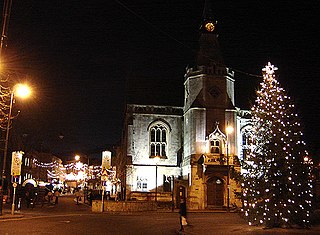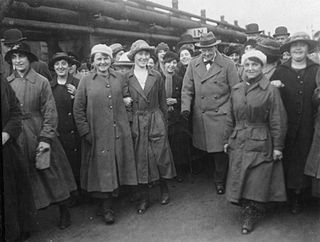Related Research Articles

Royal Ordnance Factory (ROF) Bridgwater was a factory between the villages of Puriton and Woolavington in the Sedgemoor district of Somerset, England that produced high explosives for munitions. It was slightly above sea level, between the 5-and-10-metre contour lines on Ordnance Survey maps. BAE Systems closed it when decommissioning was completed in July 2008.

The Shell Crisis of 1915 was a shortage of artillery shells on the front lines in the First World War that led to a political crisis in the United Kingdom. Previous military experience led to an over-reliance on shrapnel to attack infantry in the open, which was negated by the resort to trench warfare, for which high-explosive shell were better suited. At the start of the war there was a revolution in doctrine: instead of the idea that artillery was a useful support for infantry attacks, the new doctrine held that heavy guns alone would control the battlefield. Because of the stable lines on the Western Front, it was easy to build railway lines that delivered all the shells the factories could produce. The 'shell scandal' emerged in 1915 because the high rate of fire over a long period was not anticipated and the stock of shells became depleted. The inciting incident was the disastrous Battle of Aubers, which reportedly had been stymied by a lack of shells.
ROF Glascoed was built as a UK government-owned, Royal Ordnance Factory (ROF). It was designed as one of 20 munitions filling factories. It was planned as a permanent ROF with the intention that, unlike some other similar facilities, it would remain open for production after the end of World War II. After privatisation of the Royal Ordnance Factories in the 1980s it became part of Royal Ordnance plc and later a production unit of BAE Systems.
ROF Bridgend,, located in Bridgend, South Wales, was one of the largest of sixteen World War II, UK government-owned, Royal Ordnance Factory munitions Filling Factories. Of great significance to the Britain's war effort, at its peak of production it employed around 40,000 people — said to be the largest ever factory in Britain's history.
An explosive ROF was a UK government-owned Royal Ordnance Factory (ROF), which specialised in manufacturing explosives during and after World War II. In World War I, the name used in the UK for government-owned explosives factories was National Explosives Factory; the cordite factory at Gretna was known as HM Factory, Gretna.

Royal Ordnance Factories (ROFs) were munitions factories run by the UK government during and after the Second World War. The three main types of factories were engineering, filling and explosives, and these were dispersed across the country for security reasons. ROFs were the responsibility of the Ministry of Supply and later the Ministry of Defence until privatisation in 1987.
ROF Thorp Arch was one of sixteen Second World War, UK government-owned Royal Ordnance Factory, which produced munitions by "filling" them. It was a medium-sized filling factory.
A filling factory was a manufacturing plant that specialised in filling various munitions, such as bombs, shells, cartridges, pyrotechnics, and screening smokes. In the United Kingdom, during both world wars of the 20th century, the majority of the employees were women.
Royal Ordnance Factory (ROF) Elstow was one of sixteen UK Ministry of Supply, World War II, Filling Factories. It was a medium-sized filling factory,, which filled and packed munitions. It was located south of the town of Bedford, between the villages of Elstow and Wilstead in Bedfordshire. It was bounded on the northeast by the A6 and on the west by a railway line. Hostels were built nearby to accommodate the workers who were mostly female.
A World War I explosive factory, which was to be later known as NEF Pembrey was built, by Nobel's Explosives, with British Government approval, near the village of Pembrey, Carmarthenshire, Wales. The factory was built on a site consisting of mainly sandhills and sand dunes to provide some protection against damage caused by an explosion. Its main product was TNT (Trinitrotoluene) used for shell filling. The same site was used in World War II to build another explosive factory ROF Pembrey, which also made TNT.
RAF Credenhill, also known as RAF Hereford, was a non-flying station of the Royal Air Force situated in the village of Credenhill near Hereford, England, United Kingdom. It was commissioned in 1940 and served as home for a range of training schools from 1940 until closure in 1994. The site was subsequently obtained by the British Army.

The National Shell Filling Factory, Chilwell, was a World War I United Kingdom Government-owned explosives filling factory. Its formal title was National Filling Factory No. 6. It was located near Chilwell, at that time a village, in Nottinghamshire on the main road from Nottingham to Ashby de la Zouch. During the Great War it filled some 19 million shells with high explosives.
ROF Kirkby, was a large World War II Royal Ordnance Factory (ROF) filling munitions. The factory was based in the rural area of Kirkby, on the outskirts of Liverpool, Merseyside. The rural location was to reduce the potential damage from any accidental explosions. Munitions were produced from September 1940 to March 1946.
ROF Risley, was a large World War II Royal Ordnance Factory filling munitions, including the Grand Slam bomb, in the UK. It is located roughly halfway between Liverpool and Manchester.

Chittening is an industrial estate in Avonmouth, Bristol, England, bypassed by the A403 road, near the River Severn. It lies within the city boundary of Bristol, in Avonmouth ward, but used to be beyond it, in historic Gloucestershire, on former marshland at the southern end of the Vale of Berkeley.

Banbury is a circa 1,500-year-old market town and civil parish on the River Cherwell in the Cherwell District of Oxfordshire, England. It is 64 miles (103 km) northwest of London, 38 miles (61 km) southeast of Birmingham, 27 miles (43 km) south of Coventry and 21 miles (34 km) north northwest of the county town of Oxford.

ROF Swynnerton was a Royal Ordnance Factory, more specifically a filling factory, located south of the village of Swynnerton in Staffordshire, United Kingdom. Built between 1939 and 1941, it remained operational until 1958. It is now operated by the Defence Training Estate, as Swynnerton Training Camp.
ROF Rotherwas was a Royal Ordnance Factory filling factory, No 4, located in Rotherwas, Dinedor Parish, Herefordshire, England.

The National Filling Factory, Georgetown, was a First World War munitions factory situated near Houston in Renfrewshire, Scotland. It is believed that the Ministry of Munitions owned up to 12 filling factories; Georgetown was known as NFF.4.

The Grangeston Halt railway station was a private station that was not listed in the public timetables, located in a rural part of South Ayrshire, Scotland and served the WWII Grangeston ICI munitions plant bringing workers to the site. Grant's Distillery now occupies much of the site.
References
- 1 2 3 4 5 6 7 8 9 10 11 12 "Banbury shell filling factory played vital role during First World War". Banbury Guardian. 23 April 2012. Retrieved 13 July 2015.
- ↑ "Banbury shell filling factory played vital role during First World War". Banburyguardian.co.uk. Retrieved 13 July 2015.
- ↑ "BBC - World War One At Home, Grimsbury, Oxfordshire: Canary Babies". BBC.co.uk. Retrieved 13 July 2015.
- ↑ "National Filling Factory, Banbury". Invisionzone.com. Retrieved 13 July 2015.
- 1 2 3 4 5 6 7 8 9 10 11 12 13 14 15 16 17 Historic England. "Former World War I National Filling Factory, Banbury (1409811)". National Heritage List for England . Retrieved 14 May 2014.
- 1 2 3 4 5 6 7 8 "Banbury shell filling factory played vital role during First World War". Banbury Guardian . Retrieved 14 May 2014.
- 1 2 3 "Royal Ordnance Factory Rotherwas". Herefordshire County Council. Archived from the original on 14 May 2014. Retrieved 13 May 2014.
- 1 2 3 Edmonds, John (2004). The History of Rotherwas Munitions Factory, Hereford. Logaston Press.
- ↑ Haber L.F. (1986). "10". The Poisonous Cloud. Oxford University Press. ISBN 9780198581420.
- ↑ Ian F.W. Beckett (31 December 2013). The Home Front 1914-1918: How Britain Survived the Great War. ISBN 9781472908896 . Retrieved 13 May 2014.
- ↑ "Slough Trading Estate". Everything2.com. Retrieved 13 July 2015.
- ↑ p 109, The History of Slough, Maxwell Fraser, Slough Corporation, 1973
- ↑ "Foreign News: Wal's Work". TIME.com. 20 February 1939. Archived from the original on 14 December 2008.
- ↑ Cassell, Michael (1991). Long Lease!, The Story of Slough Estates 1920 – 1991. London: Pencorp Books.
- 1 2 "World War II grenades uncovered at Banbury building site". BBC News.